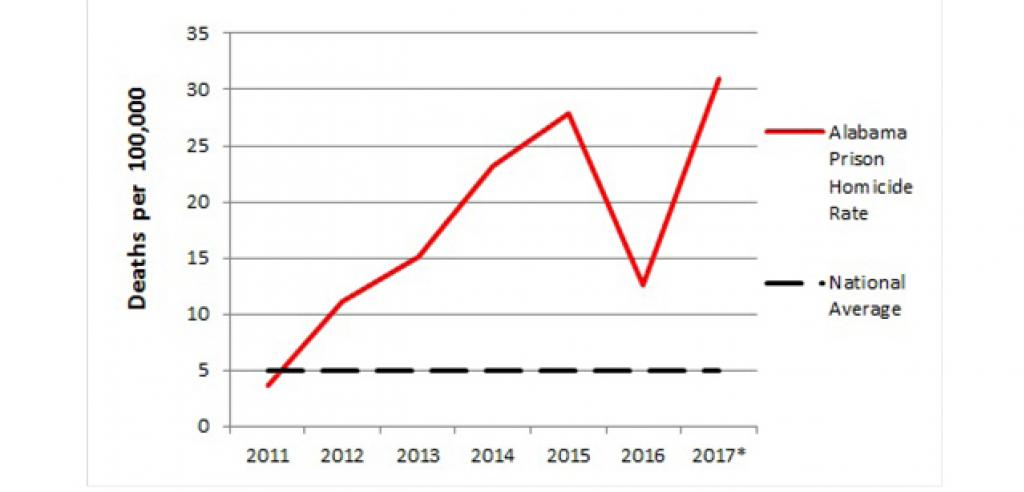Cedric Jerome Robinson, 33, was killed at Bibb County Correctional Facility in Brent, Alabama, on September 8. He was serving a six-year sentence for fraudulent use of a credit card and possession of a forged instrument, and was to be released in February 2018. Mr. Robinson was the eighth person killed in an Alabama prison so far this year, putting 2017 on track to be the bloodiest year in recent history for Alabama’s prison system.
The number of people killed in the state’s prisons increased every year since 2011, when one homicide was reported for the year, through 2015, when seven people were killed in a single year. After a brief downtick in 2016, prison homicides are on the rise again, making Alabama’s prison system the most violent in the country.
Alabama’s prison homicide rate is more than six times the national average. The national average is five homicides per 100,000 incarcerated people. Alabama’s rate is more than 30 per 100,000 people – more than double the rate of the next most violent state.
Alabama also is an outlier in terms of the sheer number of incarcerated people killed. In 2015, despite holding only 2 percent of the nation’s prison population, Alabama was responsible for 10 percent of the nation’s prison homicides. That year, Alabama had more prison killings than either Florida or Texas, even though those states incarcerate roughly five times as many people as Alabama.
The prison homicide rate is a symptom of an epidemic of violence in Alabama’s prisons. As the New York Times and the Washington Post have observed, violence in the state’s prisons can be directly linked to preventable factors like overcrowding, broken locks on cell doors, the failure of prison officials to keep prisons free of drugs and weapons, and “a culture that tolerate[s] violence.”
The rise of prison assaults and killings in Alabama mirrors an equally troubling spike in inmate suicides. This summer, a federal court ruled that Alabama fails to provide constitutionally adequate mental health care to people in state prisons, finding that mental health services are “horrendously inadequate” and have led to a “skyrocketing suicide rate” among incarcerated people.
Over the past few years, the suicide rate in Alabama prisons increased from 5 suicides per 100,000 incarcerated people to 37 per 100,000 during the 2015-2016 fiscal year. The rate is projected to be as high as 60 per 100,000 in the current fiscal year. The national rate is around 16 per 100,000, and the State of Alabama’s expert witness told the federal court he was unaware of any other jurisdiction in the United States with a suicide rate over 30 per 100,000.
The federal court linked Alabama’s escalating suicides to a variety of preventable factors including, most prominently, “inadequate identification of those who are at heightened risk of suicide, combined with a culture of cynicism towards prisoners’ threats of suicide and self-harm and a severe shortage of crisis cells.” The court wrote that the Alabama Department of Corrections’s reluctance to take mental health concerns seriously poses “obvious risks” to incarcerated people’s health and safety.
As the rising prison homicide and suicide rates suggest, the need for systematic reforms and cultural change to ensure prisoner safety is increasingly urgent. Until the Alabama Department of Corrections implements serious reforms, the uniquely appalling conditions endured by people in Alabama prisons will continue to deteriorate.
